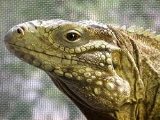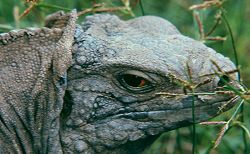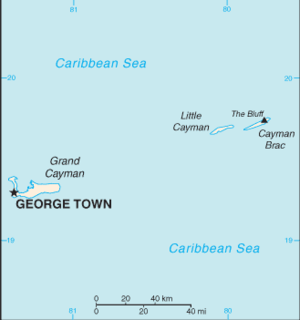
Cyclura nubila caymanensis
Encyclopedia
The Lesser Caymans Iguana or Cayman Brac Iguana or Cayman Island Brown Iguana or Sister Isles Iguana (Cyclura nubila caymanensis) is a critically endangered subspecies of the Cuban Iguana (Cyclura nubila
). It is native to two islands to the south of Cuba
: Cayman Brac
and Little Cayman
, which are also known as the Sister Isles due to their similar shapes and close proximity to each other. This subspecies is in decline due to habitat encroachment by human development and predation by feral dogs and cats. It is nearly extinct on Cayman Brac (less than 50 animals) and Little Cayman supports a population of 1,500 animals.
. This subspecies has been introduced to Grand Cayman, where it has interbred with that island's native Blue Iguana
, (Cyclura Lewisi).
The generic
name (Cyclura
) is derived from the Ancient Greek
cyclos (κύκλος) meaning "circular" and ourá (οὐρά) meaning "tail", after the thick-ringed tail characteristic of all Cyclura. Its specific
name, nubila, is Latin
for "gray" but in this instance is a Latinized
form of the name of John Edward Gray
, the British
zoologist
who first described the Cuban Rock Iguana as a species in 1831 as opposed to the animal's base color. Its subspecific name Caymanensis refers to the island where it lives being a Latinized form of "Cayman".
Zoologists Thomas Barbour
and Gladwyn Kingsley Noble
first described the Lesser Caymans Iguana as a species in 1916. Chapman Grant
, in a monograph published in 1940, formally described the Lesser Caymans Iguana for the first time as a subspecies: Cyclura macleayi caymanensis.
In 1975 Albert Schwartz and Thomas established the trinomial nomenclature
, Cyclura nubila caymanensis for the Lesser Cayman Iguana. They maintained that this lizard was a subspecies of Cyclura nubila nubila commonly known as the Cuban Rock Iguana(the species from which it evolved and can breed with if placed together under artificial conditions).
 The Lesser Caymans Iguana, Cyclura nubila caymanensis, is a medium to large animal with an average total length between 30 and 40 inches. Males are significantly larger than females. The Lesser Caymans Iguana has a skin color from light grey to green when mature, with a light blue or reddish-pink colored head, whereas females are more olive green, lacking any red or blue. Young animals tend to be uniformly dark brown or green with faint dark bands. Their distinctive black feet stand in contrast to the rest of their lighter overall body color. Their eye-color is typically brown to blood red. An individual of this subspecies has been recorded as one of the longest lived of all species and subspecies of the genus Cyclura at 33 years.
The Lesser Caymans Iguana, Cyclura nubila caymanensis, is a medium to large animal with an average total length between 30 and 40 inches. Males are significantly larger than females. The Lesser Caymans Iguana has a skin color from light grey to green when mature, with a light blue or reddish-pink colored head, whereas females are more olive green, lacking any red or blue. Young animals tend to be uniformly dark brown or green with faint dark bands. Their distinctive black feet stand in contrast to the rest of their lighter overall body color. Their eye-color is typically brown to blood red. An individual of this subspecies has been recorded as one of the longest lived of all species and subspecies of the genus Cyclura at 33 years.
Being much lager than females, males have more prominent dorsal
crests in addition to prominent femoral pore
s on their thighs, which are used to release pheromones. Females have less prominent pores and have shorter crests than the males making the animals sexually dimorphic
.
 Native to the islands of Little Cayman and Cayman Brac, this subspecies has been introduced to Grand Cayman.
Native to the islands of Little Cayman and Cayman Brac, this subspecies has been introduced to Grand Cayman.
Like other members of the Genus Cyclura the Lesser Caymans Iguana requires suitable areas in which to bask, forage, nest, and hide. On Little Cayman these requirements are met in a variety of interior habitats even though the iguanas are widely dispersed.
Predation and injury to hatchlings by rats, to hatchlings and sub-adults by semi-domestic and feral cat
s, and killing of adults by roaming dogs
are all placing severe pressure on the remaining wild population on both islands.
Cyclura nubila
Cyclura nubila, also known as the Cuban rock iguana, Cuban ground iguana, or Cuban iguana, is a species of lizard of the iguana family. It is the largest of the West Indian rock iguanas , one of the most endangered groups of lizards...
). It is native to two islands to the south of Cuba
Cuba
The Republic of Cuba is an island nation in the Caribbean. The nation of Cuba consists of the main island of Cuba, the Isla de la Juventud, and several archipelagos. Havana is the largest city in Cuba and the country's capital. Santiago de Cuba is the second largest city...
: Cayman Brac
Cayman Brac
Cayman Brac is an island that is part of the Cayman Islands. It lies in the Caribbean Sea about 90 miles northeast of Grand Cayman and 5 miles east of Little Cayman. It is about 12 miles long, with an average width of 1 mile...
and Little Cayman
Little Cayman
Little Cayman is an island that is part of the Cayman Islands. It is located in the Caribbean Sea, about 75 miles northeast of Grand Cayman and five miles west of Cayman Brac. Little Cayman has a permanent population of less than 170 and is about 10 miles long with an average width of 1 mile...
, which are also known as the Sister Isles due to their similar shapes and close proximity to each other. This subspecies is in decline due to habitat encroachment by human development and predation by feral dogs and cats. It is nearly extinct on Cayman Brac (less than 50 animals) and Little Cayman supports a population of 1,500 animals.
Taxonomy
The Lesser Caymans Iguana, Cyclura nubila caymanensis, is endemic to the islands of Little Cayman and Cayman Brac. It is a subspecies of the Cuban IguanaCyclura nubila
Cyclura nubila, also known as the Cuban rock iguana, Cuban ground iguana, or Cuban iguana, is a species of lizard of the iguana family. It is the largest of the West Indian rock iguanas , one of the most endangered groups of lizards...
. This subspecies has been introduced to Grand Cayman, where it has interbred with that island's native Blue Iguana
Blue Iguana
The Blue Iguana or Grand Cayman Iguana is a critically endangered species of lizard of the genus Cyclura endemic to the island of Grand Cayman. Previously listed as a subspecies of the Cuban Iguana, it was reclassified as a separate species in 2004 because of genetic differences discovered four...
, (Cyclura Lewisi).
The generic
Genus
In biology, a genus is a low-level taxonomic rank used in the biological classification of living and fossil organisms, which is an example of definition by genus and differentia...
name (Cyclura
Cyclura
Cyclura is a genus of lizards from the family Iguanidae. Members of this genus are known as "cyclurids" or more commonly as rock iguanas and only occur on islands in the West Indies...
) is derived from the Ancient Greek
Ancient Greek
Ancient Greek is the stage of the Greek language in the periods spanning the times c. 9th–6th centuries BC, , c. 5th–4th centuries BC , and the c. 3rd century BC – 6th century AD of ancient Greece and the ancient world; being predated in the 2nd millennium BC by Mycenaean Greek...
cyclos (κύκλος) meaning "circular" and ourá (οὐρά) meaning "tail", after the thick-ringed tail characteristic of all Cyclura. Its specific
Species
In biology, a species is one of the basic units of biological classification and a taxonomic rank. A species is often defined as a group of organisms capable of interbreeding and producing fertile offspring. While in many cases this definition is adequate, more precise or differing measures are...
name, nubila, is Latin
Latin
Latin is an Italic language originally spoken in Latium and Ancient Rome. It, along with most European languages, is a descendant of the ancient Proto-Indo-European language. Although it is considered a dead language, a number of scholars and members of the Christian clergy speak it fluently, and...
for "gray" but in this instance is a Latinized
Latinisation (literature)
Latinisation is the practice of rendering a non-Latin name in a Latin style. It is commonly met with for historical personal names, with toponyms, or for the standard binomial nomenclature of the life sciences. It goes further than Romanisation, which is the writing of a word in the Latin alphabet...
form of the name of John Edward Gray
John Edward Gray
John Edward Gray, FRS was a British zoologist. He was the elder brother of George Robert Gray and son of the pharmacologist and botanist Samuel Frederick Gray ....
, the British
United Kingdom
The United Kingdom of Great Britain and Northern IrelandIn the United Kingdom and Dependencies, other languages have been officially recognised as legitimate autochthonous languages under the European Charter for Regional or Minority Languages...
zoologist
Zoology
Zoology |zoölogy]]), is the branch of biology that relates to the animal kingdom, including the structure, embryology, evolution, classification, habits, and distribution of all animals, both living and extinct...
who first described the Cuban Rock Iguana as a species in 1831 as opposed to the animal's base color. Its subspecific name Caymanensis refers to the island where it lives being a Latinized form of "Cayman".
Zoologists Thomas Barbour
Thomas Barbour
Thomas Barbour was an American herpetologist. From 1927 until 1946, he was director of the Museum of Comparative Zoology founded in 1859 by Louis Agassiz at Harvard University in Cambridge, Massachusetts....
and Gladwyn Kingsley Noble
Gladwyn Kingsley Noble
Gladwyn Kingsley Noble was an American zoologist.- Works :*"American Egret at Martha's Vineyard, Mass" The Auk Vol. 31 N. 1: 100...
first described the Lesser Caymans Iguana as a species in 1916. Chapman Grant
Chapman Grant
Chapman Grant was an American herpetologist, historian, and publisher. He was the last living grandson of United States President Ulysses S. Grant...
, in a monograph published in 1940, formally described the Lesser Caymans Iguana for the first time as a subspecies: Cyclura macleayi caymanensis.
In 1975 Albert Schwartz and Thomas established the trinomial nomenclature
Trinomial nomenclature
In biology, trinomial nomenclature refers to names for taxa below the rank of species. This is different for animals and plants:* for animals see trinomen. There is only one rank allowed below the rank of species: subspecies....
, Cyclura nubila caymanensis for the Lesser Cayman Iguana. They maintained that this lizard was a subspecies of Cyclura nubila nubila commonly known as the Cuban Rock Iguana(the species from which it evolved and can breed with if placed together under artificial conditions).
Anatomy and morphology

Being much lager than females, males have more prominent dorsal
Dorsum (biology)
In anatomy, the dorsum is the upper side of animals that typically run, fly, or swim in a horizontal position, and the back side of animals that walk upright. In vertebrates the dorsum contains the backbone. The term dorsal refers to anatomical structures that are either situated toward or grow...
crests in addition to prominent femoral pore
Femoral pore
Femoral pores are a part of a holocrine secretory gland found on the inside of the thighs of certain lizards and amphisbaenians which releases pheromones to attract mates or mark territory. In certain species only the male has these pores and in other species, both sexes have them, with the males...
s on their thighs, which are used to release pheromones. Females have less prominent pores and have shorter crests than the males making the animals sexually dimorphic
Sexual dimorphism
Sexual dimorphism is a phenotypic difference between males and females of the same species. Examples of such differences include differences in morphology, ornamentation, and behavior.-Examples:-Ornamentation / coloration:...
.
Distribution and habitat

Like other members of the Genus Cyclura the Lesser Caymans Iguana requires suitable areas in which to bask, forage, nest, and hide. On Little Cayman these requirements are met in a variety of interior habitats even though the iguanas are widely dispersed.
Diet
Like all Cyclura species the Lesser Caymans Iguana is primarily herbivorous, consuming leaves, flowers and fruits from over 100 different plant species. This diet is very rarely, if ever supplemented with animal matter.Mating
Mating occurs in April to May depending when the dry season ends, and 7-25 eggs are usually laid in May or June depending on the size and age of the female. Due to being forced to dwell inland where the soil is rocky, the females often have to migrate to coastal areas in order to build their nests in the sand. The hatchlings emerge from the nests in August to early September.Endangered status
The Lesser Caymans Iguana is critically endangered according to the current IUCN Red List. The subspecies is vital to its native ecosystem as a seed disperser for native vegetation, and its extinction could have serious consequences as many of Little Cayman's and Cayman Brac's plants are not found elsewhere.Causes of decline
Habitat destruction is the main factor threatening the future of this iguana. The iguanas nest in the sand of beaches that are a prime real-estate location on Little Cayman.Predation and injury to hatchlings by rats, to hatchlings and sub-adults by semi-domestic and feral cat
Feral cat
A feral cat is a descendant of a domesticated cat that has returned to the wild. It is distinguished from a stray cat, which is a pet cat that has been lost or abandoned, while feral cats are born in the wild; the offspring of a stray cat can be considered feral if born in the wild.In many parts of...
s, and killing of adults by roaming dogs
Pariah dog
The term pariah dog originally referred to Chinese/Indian feral dogs of a particular type, but it is now used by the United Kennel Club to refer to a purebred dog category.- Feral dogs of India :...
are all placing severe pressure on the remaining wild population on both islands.

